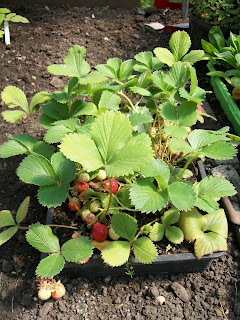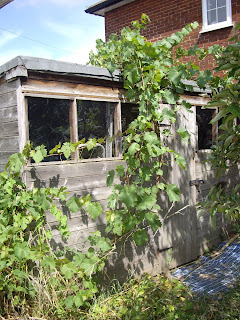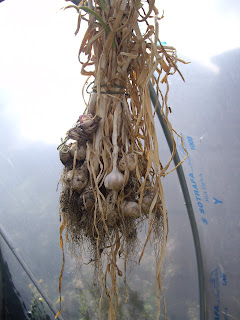
My last post focussed on the progress of the winter crops in the garden, this time around it's the turn of the spring and summer crops. This year we made good use of the compost we made on site, it was a bit twiggy but jammed packed with nutrients which helped speed up the growth of our vegetable plants. Our compost had been rotting down for almost a whole year and it was made up of a combination of kitchen waste, garden waste, discarded newspapers and old cardboard boxes. We avoided cooked food as much as we could but the occasional left over rice and some mouldy bread were added to the mix. The result was rewarding, and to think all of this could have been sitting in a landfill somewhere just wasting away.
The sunflowers I wrote about in the last but one post had grown very quickly and produced some very lovely looking flowers of different colours.

Impressive Sunflowers (9ft tall)

We planted a variation of vegetables this year. We had squash, lettuce, beans, sweet corn, carrots, swede and potatoes just to name a few. In June most of the crops which were started off in the mini green houses were transplanted out into their final growing site, and by mid July there was very significant growth on the site.
So first there was the sunflowers, which brought levels, colour and, a large insect interest into the garden. We also grow a few squash plants. The first variety of squash we planted was from seeds collected and stored from last year's harvest of the squash 'Festival' we grew last season. The squash 'Festival' is a very fast growing hardy crop and requires a fair bit of space to grow to it's full potential. As mentioned earlier we started the plants off from last seasons seeds in mid April. By June the young plants had outgrown their pots and were now strong enough to be planted out.

Squash 'Festival' in June
A few short weeks on the plants flowered and started to form fruit. By mid July the plants had claimed the entire section to themselves. We had earlier planted some sweet peas on the same site and these were supported by covering a small section of the fence with plastic netting, allowing the sweet peas to wrap their way up the fence. To our surprise the squash also mad good use of this artificial staircase to the skies.

In July
The second variety of squash we planted was the squash 'Straight neck'. Also a fast grower but we found it to be very inefficient. We planted them at similar times to the squash 'festival' but we only got one crop per plant. It is a more compact plant than the festivals and therefore requires less space however the festival variety in my opinion has an advantage in flavour.

Squash 'Straight Neck' in July
We managed to acquire a few red seed corn from Peru and decided to plant them out and see how they did in the UK climate. Our sweet corn were planted in early May and spent their first few weeks of life in the mini green houses. Once they were large enough to handle carefully we transplanted them to their final grow site.

Sweet Corn 'Kelvedon Glory'(left), 'Peruvian'(right)
As well as the new Peruvian corn, we also planted a variety called Kelvedon Glory F1. In July the tassels and silk ears began to form on the kelvedon variety the Peruvian kept growing taller and taller but never formed any tassels.

Corn in July
We attempted four different types of beans this season. Broad beans we covered in previous posts, two different varieties of runners, and French dwarfs. One of the runners we used was 'Borlotta Lingua Di Fuoco'. This variety is easy to grow but is a delicacy for snails and slugs when young. This sample was started from seed in the mini greenhouse in early March and transfered in late May.

Climbing French Beans - June
In July we were able to harvest the first set of mature pods. The plants quickly began to out grow their supporting fame-work and extensions had to be made.

Climbers carrying on
We also planted four French Dwarf Bean plants which were from seeds saved by a volunteer worker on the site from their own growing site. These were sowed in May and were ready for picking in July. We like this plant because it is easy to grow and the yield per plant very high.

French Revolution: dwarfs and runners in July
The final bean type we tried this season was a Peruvian runner. We planted these from seed around the same time as the dwarfs, late April - early May. This is a fast grower but takes a while to begin producing veg. It's late September and we are only just seeing signs of flowers.
Swede is a vegetable which has always interested my. We grew a variety called 'Helenor', very quick and easy to germinate but also very much liked by slugs. We lost a whole tray in the space of two nights. It was advised that the seeds should be sowed directly into the final grow site but we found that It was near impossible to protect the young tender plants form the devastating effects of a visit from the neighborhood slug. We therefore started them off in clusters in medium size pots in the mini green house, where they were better protected against slug and snail attacks. We planted the swedes in April and transfered them in late May.

Swede 'Helenor' two weeks after transference
Not too long after being planted out the plants came under attacks from white files, green flies, aphids, black flies and caterpillars and we though we would loose the entire crop. In July we began to see the emergence of the root tops after weeks of spraying off flies using a insecticide sprayer filled with a light water/washing up liquid mix.This treatment coupled with the arrival of many new predatory insects to the garden had seemed to solve the pest problems.

Swede 'Helenor' in July
This season we planted some onions from seed. The variety we planted was called 'White Lisbon' easy to germinate and requires very little up keep. These were sowed in modules early in the year, February, and planted out once the weather had warmed up. They were planted out in May and were ready for harvesting by July.

Onion 'White Lisbon' - July
Last years' potato harvest was a great success but we did have a small blight problem. This year we went for a blight resist variety called 'Romano'. This is a red potato which boosted high yields and a high disease resistance. We planted them out in March and they have done well up to now. We harvested a few last month (August) and they were formed perfectly with no evidence of disease.

The potato patch before (March) and after (July)

Tomatoes has been a favorite on allotments for a long time. This year we planted a few varieties. Last year we went with the 'Money Maker' and 'My Girl' varieties and were overwhelmed by the harvest. We tried the 'Golden Sunrise' and 'Alicante' varieties of vine tomato. To avoid having a huge surplus of tomatoes at the end of the season we planted in intervals. The first set were planted in late February in the green house then planted out in April. The second set were sowed in late March to early April. These two varieties are easy to grow but require constant watering and pruning. A small tip: The tomato roots love water however the leaves don't, avoid wetting the plant directly.

'Sunrise' in June (above) and in July (below)

Some time ago I was browsing the internet and came upon someone trying to get rid of some hanging baskets on freecycle.org and was lucky enough to acquire them. We then began to brainstorm what we could plant in the baskets. We tried strawberries but to kept drying out. This season we sowed cherry tomatoes, two varieties. The first was called 'Lidl' and the other 'Gartenperle'. They are easy ti grow but as they constraint to a small area they require regular feeding, and it is a good idea to line the bottom of the basket with a less porous material like plastic to help retain moisture. We were not very consistent on the feeding aspect and as a result our yield was not very impressive.

Cherry tomatoes 3 1/2 weeks after sowing

6 weeks later
We like leeks and so we reserved a large area for leeks. We used the variety known as 'Musselburgh'. These were sowed in trays in March and planted out in mid May. Very easy to manage plant with no pest that we could notice.

Leek 'Musselburgh' in June (left) and July (right)
Our new technique for growing cabbages, discussed in previous posts assured that we would be harvesting cabbages this season. In winter we sowed the seeded and once germinated we feed them with liquid fertilizer produced right on site at May Gardens. Our feed consist of comfrey and nettle leaves soaked in water for a minimum of two weeks.

Cabbages in June (above)
and our first head (below)

A few more crops I need to tell you about before we get into whats' been going on inside the polytunnel. The strawberries completed their second season in July and what a harvest it was. We ended up with quite a lot of strawberries and had to freeze some. Our strawberry patch started off with three or four small plants and soon the entire plot was covered with little runners which then anchored themselves to the ground by sending down roots. The first flowers appeared in May and we got our first look at what we could expect. Picking began in June, we had a few pots of strawberry plants which were started from cuttings of one of the original plants.

Strawberries under netting in June
Like the mint plant, strawberry plants are very hardy and spreads like crazy. If you have a strawberry plant which has grown out of control just simply take off a few runners, ones which have already started sending out roots are best, and plant them in large pots and then the mother plant can be cut right back. Strawberry plants are tough resilient plants and only really require protection from the birds and other creatures of the garden as special treatment once they start fruiting.

One of the off-cuts
They said it could not be done. We were told that transplanting carrots is not a good idea, but we are all about experimenting and experiencing. We sowed some carrot 'Autumn King' and 'Nantes' from March onwards. The 'Nantes' we sowed directly into the ground inside the polytunnel in March, more on those later. The 'Autumn King' variety we planted in trays from April in the green houses and transplanted them outside once they were large enough to handle carefully. They respond very well to their ordeal.

Carrot 'Autumn King' in July
The other two fruits we have growing in the garden are also doing well. The apple tree is as productive as ever, the worms are still causing a bit of a problem however there is more than enough to go around.

Ye old Apple tree
The grape vine has also been a success, we cut it all the way back in Autumn and the new growth had began to emerge in mid spring. We managed to harvest some grapes in August and they were lovely sweet.

The Grape Vine in July
And there you have it. That's most of what's happening in the outdoor garden at May Project Garden. We also have a few wild areas where wild flowering plants and grasses grow with minimum disturbance. A large dry wood pile was accumulated over the past two winters, and it serves as a source of endless fuel for our rocket stove.

Our wood pile
And so until next time when we would be looking at the happenings inside the polytunnel, I leave you with a few snapshots of the garden.












